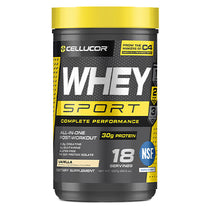The branched-chain amino acids, or BCAAs, so called because of their forked (or "branched") chemical structure, are three specific amino acids: leucine, isoleucine, and valine.
These powerhouse aminos are unique among all amino acids. They perform several critical metabolic and physiological functions, and can provide multiple physique and performance benefits for people who want to build muscle, burn fat, and support overall recovery from their workouts.
Let's take a closer look at what BCAAs are, how they work, how to utilize them in your supplement arsenal, and how to get maximum benefit from taking them.
What Are Amino Acids and What Do They Do?
Amino acids are organic compounds that, put simply, function as the building blocks or structural units of protein. In general, 20 different amino acids—nine essential and 11 non-essential—combine to form our bodies’ various proteins, including muscle proteins.
In addition to forming proteins, amino acids can serve as an energy source for skeletal muscle function, and individual amino acids contribute to various bodily functions.
What Are BCAAs and Why Are They Important?
BCAAs are three of the nine essential amino acids—essential meaning that we must provide them to our bodies through nutrition or supplementation. Unlike all other amino acids, BCAAs are primarily metabolized and utilized in skeletal muscle (4, 5).
In muscle, BCAAs serve a variety of essential purposes. Most importantly for physique and performance athletes, BCAAs are the building blocks required for the synthesis of other amino acids and proteins. BCAAs promote protein synthesis, and one particular BCAA, leucine, activates a key pathway in the body (known as mTOR) that stimulates muscle protein synthesis, or MPS (6).
BCAAs may also promote muscle repair and recovery by decreasing protein breakdown, which could have a positive impact on DOMS, or delayed-onset muscle soreness. Two different systematic reviews on BCAA supplementation showed that they had potential for alleviating muscle damage, when consumed in high doses for a consistent amount of time prior to exercise, especially when compared to passive recovery alone(7,8).
Another reason BCAAs are of interest to athletes is that their supplementation may support improved exercise performance. A systematic review of BCAAs effects on exercise found that they reduced markers associated with fatigue and muscle soreness like lactate levels, ammonia levels, and creatine kinase levels(9).
In other words, BCAAs can help build, maintain, and repair muscle, and can be thought of as beneficial to your muscle growth and workout recovery!
When Should I Take BCAAs?
Research across the past 50-plus years has provided very solid evidence that ingesting specific amino acids (i.e., BCAAs) around resistance exercise augments the rate of skeletal muscle protein synthesis to a greater extent than either amino acid supplementation or resistance exercise alone (1, 2).
More specifically, consuming BCAAs in scientifically researched and evidence-based quantities before, during, and after your resistance exercise stimulates an increase in MPS, helping you build muscle, and is even necessary to shift net muscle protein balance—defined as muscle protein synthesis minus muscle protein breakdown (MPB)—from negative to positive, or to a state of growth (anabolism) (3).
If you aren’t supplementing with the right types of amino acids in beneficial amounts around your resistance exercise, you likely aren't getting the most from your hard work to build muscle, support recovery, and improve performance. The good news is that you can maximize and optimize your results from training if you supplement around your training intelligently and diligently.
Here are some easy ways to include BCAA supplements in your routine:
- Boost Your Workout Supplement Stack: While you can take BCAA supplements at any time, the most common timing for them is around your workout window (before, during, after). This helps provide your body with fuel to support muscle growth and recovery.
- Combine with food: BCAA supplements can be taken alone, but some people like to drink a BCAA mix alongside a meal. They do this as an easy way to increase their total intake of BCAAs during a meal. This can be helpful if you’re eating a meal that isn’t particularly high in protein, and especially if it’s lacking in BCAAs.
- Variety: BCAA supplements come in many different flavors, and they can be consumed in different formats including on their own, in a smoothie, or in a recipe. Choose the form that best suits your preferences.
- Stack with other supplements: BCAA supplements can be combined with other supplements to create a stack. Some common supplements that people stack with BCAAs include pre-workouts, creatine, and beta-alanine. The purpose of stacking your supplements is to create a synergistic effect that can help support your goals.
Using BCAAs to Build Muscle & Burn Fat
Maximal fat loss and muscle growth are achieved by intelligently combining several facets of programming, including nutrition, training, and supplementation. On the supplementation front, BCAAs can help you build muscle and burn fat by contributing to the following two objectives:
- Increasing lean muscle mass, which is a goal unto itself, but has the additional benefit of boosting metabolic rate and resting energy expenditure (REE) to further facilitate fat loss.
- Allowing for lipolytic (fat loss) hormonal response patterns, especially around training, to promote fat burning.
Taking a BCAA supplement before, during, and after your workout—or during what's known as the peri-workout period—is one of the most well-documented, anecdotally backed, and effective strategies you immediately implement into your programming to promote new gains in muscle mass.
Using BCAAS to Further Promote Fat Loss
To address the second objective, which is to create a fat-burning hormonal environment around your workouts, choose a BCAA supplement with extremely low quantities of sugar or other carbohydrates. By manipulating insulin levels with intelligent carbohydrate timing, you can lay the foundation for continual and extreme fat loss.
Low- to no-sugar BCAA supplementation around your workouts keeps your insulin levels low, which puts your body in a state to use stored fat, rather than blood sugar, for its energy needs. Furthermore, the BCAAs help you turn on high rates of MPS, which when turned on consistently workout after workout, contributes across time to the accretion of metabolism- and performance-boosting muscle tissue.
How Many Grams of BCAAs Should I Take Per Day?
Here’s your approach for maximum muscle growth, maintenance, and recovery:
On training days, consume a minimum of 14 grams of BCAAs per day, divided into or simply spread across the following essential times around your workouts:
- 15 minutes before training
- Immediately pre-training
- Mid-training
- Immediately post-training
To maximize your efforts, follow this strategy for both resistance training and cardiovascular exercise.
On training and non-training days, consume a minimum of 14 grams of BCAAs divided into doses taken between one or two of your solid-food meals (e.g., mid-morning, mid-afternoon).
Choosing the Right BCAA Supplement
There are a few things to look for when shopping for BCAAs: formula, dosage, and flavor.
While that last factor may seem simple, a great-tasting BCAA supplement encourages frequent usage. Who doesn't want to drink something that is beneficial, high-quality, and exceptionally delicious? Great flavor can mean the difference between consistent consumption for max results and intermittent usage.
In addition to tasting great, XTEND Original contains 7 grams of BCAAs per serving (more than most competitors), including over 3 grams of super-critical leucine—which, remember, is a key driver of muscle protein synthesis. The leucine amount in the XTEND formulas exceed the leucine threshold amount of 2 grams, the leucine amount hypothesized to increase muscle protein synthesis rates above resting amounts(10). XTEND Original is also zero sugar, carbohydrates, or calories.
The Original formula also contains a performance-driven dose of hydrating electrolytes and citrulline malate (1:1). I like to keep several flavors on hand to keep things fresh and my taste buds happy.
While you can't go wrong with the Original formula for any goal—whether you want to build muscle, burn fat, or just support your workout recovery and hydration—another great thing about XTEND is the goal-specific formulas.
If you really want to lose fat, you can take XTEND Ripped, which builds on Original with ingredients specifically selected to support fat loss.
Or, if you want to focus on endurance and performance improvement, XTEND Elite also features PeakO2, a unique ingredient that can help improve your VO2 max.
XTEND Original: Reviews from Real Users
If you're looking for more information, don't hesitate to dive into the reviews section on any XTEND product page. You'll find a wealth of good information and commentary.
For example, check out this five-star review from user Chaosmisfit:
GREAT TASTING AND GOOD RESULTS
"It's my first time trying Xtend original and I love it. It taste great and helps my body recover after a good workout faster. I used to just drink Gatorade previously but I have now switched to xtend brand exclusively for post workout recovery. I highly recommend this product and look forward to trying the rest of their product line."
Here's one more review detailing the various benefits of XTEND from user Eric78:
GREAT FOR MUSCLE RECOVERY
"I been hitting the gym 3x a week lately preparing for a 5k run for Cancer coming up. I gave tried a few powders out there for muscle growth and none have been as effective for a short term solution then Xtend. Few benefits include muscle recovery, repair, and refuel and has been super effective while I've been training for an event. Comes in a variety of flavors, I tried the Blue-Raspberry Ice 0 calories, carbs and sugar. I use all week long even on my non gym days for best results. I've experienced better endurance and faster muscle recovery and lots more energy. I feel completely hydrated while working out and aids in helping you train harder. I didn't quite like the blue-raspberry ice flavor so I'm definitely gonna try a few more but will keep this has my go to while I train for events in the future. Overall, very effective intra workout powder. I highly recommend checking it out."
Final Notes
The strategies discussed in this article are simple, sustainable, and easy to implement. Get your hands on the right BCAA formula, like any member of the XTEND lineup, do a little prep work before every training session to make your drink, and then take the supplement as instructed. Maximize your potential by arming yourself with legitimate knowledge, and then put that knowledge into practice.
SELECT REFERENCES
- Burd NA, Tang JE, Moore DR, Phillips SM. Exercise training and protein metabolism: influences of contraction, protein intake, and sex-based differences. J Appl Physiol. 2009;106:1692–1701.
- Kumar V, Atherton P, Smith K, Rennie MJ. Human muscle protein synthesis and breakdown during and after exercise. J Appl Physiol. 2009;106:2026–2039.
- Biolo G, Tipton KD, Klein S, Wolfe RR. An abundant supply of amino acids enhances the metabolic effect of exercise on muscle protein. Am J Physiol. 1997;273:E122–E129.
- Shinnick FL, Harper AE. Branched-chain amino acid oxidation by isolated rat tissue preparations. Biochim Biophys Acta. 1976;437.2:477-486.
- Buse MG, Reid SS. Leucine. A possible regulator of protein turnover in muscle. Journal of Clinical Investigation. 1975;56.5:1250.
- Blomstrand E, Eliasson J, Karlsson HK, Köhnke R. Branched-chain amino acids activate key enzymes in protein synthesis after physical exercise. The Journal of Nutrition. 2006.
- Fouré A, Bendahan D. Is Branched-Chain Amino Acids Supplementation an Efficient Nutritional Strategy to Alleviate Skeletal Muscle Damage? A Systematic Review. Nutrients. 2017 Sep 21;9(10):1047. doi: 10.3390/nu9101047. PMID: 28934166; PMCID: PMC5691664.
- Fedewa MV, Spencer SO, Williams TD, Becker ZE, Fuqua CA. Effect of branched-Chain Amino Acid Supplementation on Muscle Soreness following Exercise: A Meta-Analysis. Int J Vitam Nutr Res. 2019 Nov;89(5-6):348-356. doi: 10.1024/0300-9831/a000543. Epub 2019 Apr 2. PMID: 30938579.
- Hormoznejad, R., Zare Javid, A. & Mansoori, A. Effect of BCAA supplementation on central fatigue, energy metabolism substrate and muscle damage to the exercise: a systematic review with meta-analysis. Sport Sci Health 15, 265–279 (2019). https://doi.org/10.1007/s11332-019-00542-4
- Witard, O. C., Wardle, S. L., Macnaughton, L. S., Hodgson, A. B., & Tipton, K. D. (2016). Protein Considerations for Optimising Skeletal Muscle Mass in Healthy Young and Older Adults. Nutrients, 8(4), 181. https://doi.org/10.3390/nu8040181





















